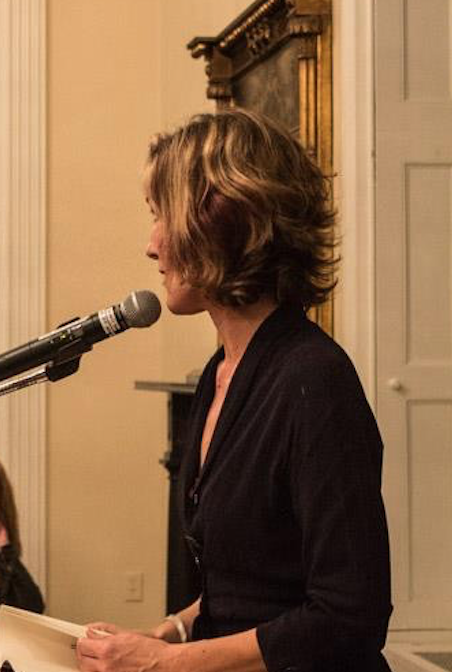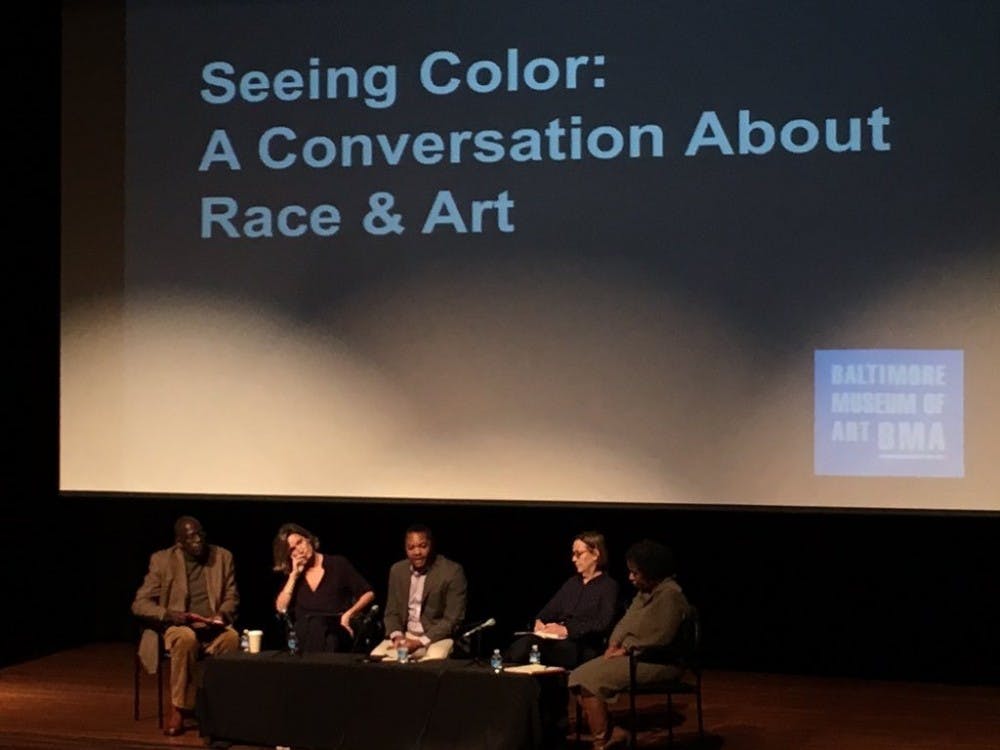By ANITA LOUIE
For The News-Letter
A gauzy pink cloth, laced with red thread embroidery. A harmless piece of fabric. Who would’ve guessed that something so lovely could be in the shape of a Ku Klux Klan (KKK) hood?
Artist and University of North Carolina at Chapel Hill professor Susan Harbage Page is Caucasian, but that hasn’t stopped her from dissecting the uncomfortable implications of racism through her art. Creating KKK hoods out of everyday materials such as powder-blue frat boy sweaters and ordinary suits, she wants to make a statement about how we create racism.
Page, along with Dr. James Smalls, Ailish Hopper and Dr. Sheri Parks, presented a panel called “Seeing Color: Race and Art” on Saturday at the Baltimore Museum of Art (BMA).
“We wanted a good balance of voices — art, historical, social science and practicing artists who deal with issues of race in their work,” Gamynne Guillotte, the BMA’s director of Interpretation and Public Engagement, said.
Rodney Foxworth, founder of a non-profit investing and social entrepreneurship organization called Invested Impact, moderated the panel which was meant to create a safe zone for a meaningful and challenging discussion on race.
Smalls, an art historian and professor at the University of Maryland, Baltimore County, started off a presentation on the paradoxical portrayal of blacks in 17th and 18th century art. Around this time period, there were over 25,100 slaves in Baltimore, hence a lot of the art featured anonymous black servants, still invisible as individuals.
In these early pieces of art, such as John Hesselius’s “Charles Calvert and His Slave,” the presence of slaves was merely used indicate the white patron’s wealth and power instead of representing the slaves themselves.
Even in art in which the artist tried to give the spotlight to a black subject, the paintings had a sense of unease that Smalls referred to as a “weird hierarchy.” For example “The Flight of Eliza” was an opulent French mantel vase created to commemorate the release of Harriet Beecher Stowe’s polarizing novel Uncle Tom’s Cabin. Despite the sound intentions of depicting the struggle of blacks, the figures were ironically rendered in a luxury item that was what Smalls described as “built from the broken backs of slaves.”
Smalls then referenced African-American artist Fred Wilson, who attempted to represent this odd disparity in his project Mining the Museum. In this project, Wilson reconfigured display cases, grouping extravagant metal workings with simple, worn slave shackles to show how some works of art are made possible by the suffering of others.

“This is not meant to be a rope of extinguishment but rather of possession, control and display,” Hopper said.
She then mentioned how few museum-goers actually bother to look up to see what the rope is hanging from because we as a whole concentrate on the tragedy of a scene, not the cause. We concentrate on the racism but not necessarily the racists.
Next she brought up another work of art, Dominique Zeltzman’s “Waiting for Something to Happen.” It’s from the point of view of a security camera. The camera is objective but, quoting the writer Toni Morrison, Hopper said that blackness is an existential position rather than just a skin color, as is whiteness.
In response, Page acknowledged her white privilege and its impact on her work.
“I know if you’re not in the effective dominant culture, someone is reminding you of your race everyday,” Page said.
She described her week-long experiment in which she carried around an empty white cardboard box for a week to constantly remind herself of her race and discovered that it was often the first thing people noticed about her.
She continued by speaking about another one of her projects in which she walked along the U.S.-Mexico border collecting bits and pieces of people’s stories such as passports and coins. She said that she was most moved by found toothbrushes since they’re such intimate items.
“Whose story was interrupted?” she asked the audience, “Who is creating our culture?”
Parks, the Associate Dean for Arts and Humanities at the University of Maryland, closed the panel. She introduced a picture of Paul Rucker’s “Birth of a Nation” project, which displays KKK robes in various materials and colors from camouflage to sparkly pink to tribal African prints. Surprising the crowd, Rucker was in the audience.
After seeing Rucker’s exhibit for the first time, Parks found a robe seller online known as Aryan Outfitters which displays KKK uniforms hanging on a clothesline after being washed — a jarringly normal setting. She reminded the audience that KKK robes are still very much in demand, a harsh reminder that the people beneath the robes are ordinary people with deep hatred.
During the Q&A portion of the talk, a woman in the audience abruptly stood and questioned the purpose of the art in the first place.
“I see black bodies lying dead in the streets in real life. I don’t want to see that in museums. What makes that art if I see it already?” she said, eliciting applause from the audience.
Guillotte responded to this challenge and spoke about the value of this violence in art.
“These objects invite both visceral emotional immediacy and, at the same time, allow for the critical distance needed for logical response, exactly the kind of mental state that is conducive to conversations that are both honest and reasoned,” Guillotte said.





